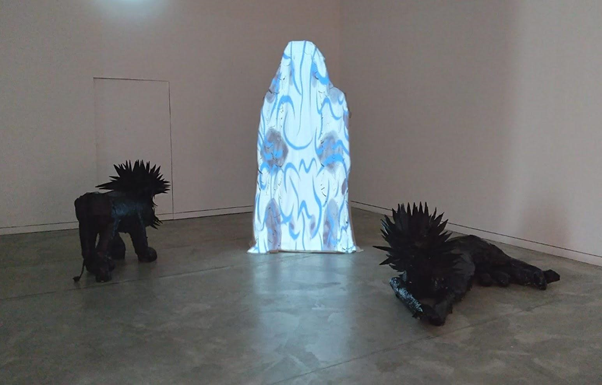Art and the Astronomical Diaries
Who can cool your raging heart?

Author: Rhonda McGovern and Celina Muldoon
Who can cool your raging heart? is a work in motion for artist Celina Muldoon based on a collaboration with researchers working with content from the Astronomical Diaries and Related Texts from Babylonia (ADART). Housed in Letterkenny’s Regional Cultural Centre, the exhibition Turas ran from 19th June to 17th September 2021.
This collaboration began with conversations surrounding the work of TCEH PhD researcher Rhonda McGovern who extracts meteorological data about Babylonian weather for the Climates of Conflict in Ancient Babylonia project in Trinity Centre for Environmental Humanities. The Akkadian designation for the Astronomical Diaries is naşāru ša ginê, which translates as ‘regular watching’. Each night and day, highly trained scribes would take their positions and literally watch the skies recording their observations on writing boards later to be transferred to clay tablets, creating astronomical cuneiform texts that have survived over two thousand years. The Astronomical Diaries are rich in content and have a high temporal resolution of sub-daily recordings, including astronomical and planetary observations, meteorological information, prices of six commodities, water levels of the Euphrates river, and historical events. Climates of Conflict in Ancient Babylonia is focussed predominantly on extracting the meteorological and historical information from the Astronomical Diaries. The project hypothesizes that patterns of violence and conflict in the Ancient Near East are linked to climatic changes including periods of drought, flooding and other extreme weather.
An example of a writing board housed in the Louvre’s Writing and Inscription Collection Online


From Astronomical Diaries to the goddess Ishtar
‘Who Can Cool Your Raging Heart’ is a work in flux. Muldoon is using the ‘Turas’ exhibition and The Regional Cultural Centre site as a testing ground for her research. Using projection mapping, animaCon, digital drawing, costume and sculpture, she sets the interactive stage for a major Live Performance. Based around the ancient Babylonian Goddess ‘Ishtar’ and the writings of her devoted high priestess Enheduanna, presented here is a scene from the Epic of Gilgamesh which depicts Ishtar with her beloved Lions. According to cuneiform inscriptions on Babylonian tablets, ‘Ishtar’ the Goddess of Love, War, and Sex was considered to represent Mother Nature. She held the power to flood territories and destroy crops which determined the crop value along the Euphrates river.

“I am presenting Ishtar with a clear reference to sculptural depictions of her in costume with a feathered cloak designed using linen. Assuming Ishtar’s mounting rage at contemporary society’s response to environmental protection, I am using digital technology to reimagine Ishtar in the contemporary world. ‘Who Can Cool Your Raging Heart’ is the title borrowed from the Enheduanna’s poem ‘The Exaltation of Inanna’; Inanna is the Sumerian title for the Goddess. I am using this as a collective expression which responds to Ishtar’s mythological power and what I perceive to be the rage of Mother Nature in this contemporary context. I am trying to conjure the power and strength of Ishtar as a trope through which we can use experiential performance and storytelling to try to effect behavioural change.”
This research will continue to unfold over the next three years through three major exhibitions of Live Art, Performance, Moving Image and Sculpture. In and around the site of three Art Institutions in Ireland, with an intention to connect with the public around topical issues in relation to Climate Action and Behavioural Change. “I believe in the potential for Art and Culture to drive critical issues. It is essential to work with experts in the field of science, to cultivate interdisciplinary collaboration and cross pollination of research. My intention is to bring people together through a collective understanding of scientific research by exploring new and ground-breaking ways to reach the public.”

